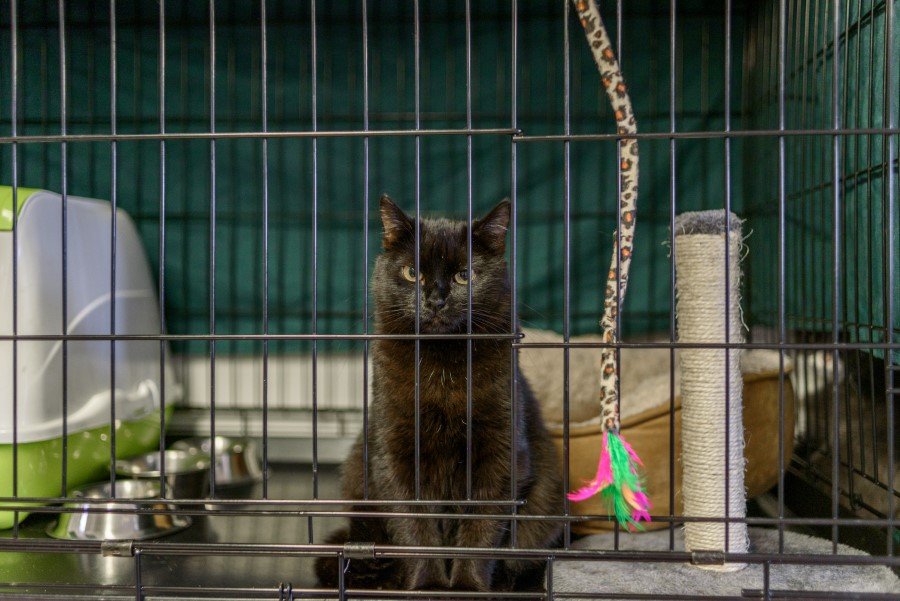
by Jonathon | | Cat Care
For many individuals going to a rescue or a shelter cat is the only way they will acquire a cat or kitten while others would not consider this. The truth is, answering the question “should I get a rescue cat” is a personal choice and there are pros and cons on both sides of the fence.
The average cat can have several litters per year if unspayed and by the time they are four years old can have given birth to up to tens of thousands of kittens. Spaying and neutering cats are imperative but many stray cats abound as they are abandoned more than dogs or puppies.
The Pros of Cat Adoption from a Rescue or Cat Shelter
This is a very satisfying method for many of obtaining a cat and some owners take in many older or unwanted cats. Let’s face it, as all cat lovers know, “cats can be like potato chips”. There is never enough! So now for the discussion on the pros. Too many times an otherwise loving cat owner becomes ill or dies and a cat becomes homeless and ends up in a shelter/rescue. We will explore both pros and cons here but chose pros first as all cats are great cats if given a chance.
-
Saving a cat who really needs love
There is a myth that cats because they are Alpha predators can do well in the wild and some end up homeless because they are left behind during a move or death or illness as we spoke of previously. This is not true. Many starve or die early of disease. The average lifespan of a cat in the wild is only five years as compared to the fifteen to the twenty-year range for a domesticated cat. Vet care, as well as good food, toys, and shelter, are just as needed by feral cats.
As mentioned above, overbreeding by cats living on their own is a real problem. . The more they breed the more the population explodes. It is a vicious cycle and many cats in the wild are abused when left to fend on their own. Older cats especially if they end up as wild cats do really badly and will gladly come to anyone that shows love. Any geriatric cat has less of a chance of adoption too as most individuals love kittens.
-
Satisfaction in knowing you are doing the right thing
There is a myth that cats that have lived outside or are older cannot be domesticated or can’t adapt eventually to new surroundings, whereas they generally do well when treated with love and kindness. While it may take some time for some to adapt they do eventually.
The younger the cat or kitten the sooner this becomes a reality but even an older feral cat does start adapting in time. It is a very welcome sight to see a feral prosper from a half-starved and anxious cat to one who cannot live without you.
-
Adopted cats can be the most loyal
They become very attached to their owners and can even experience anxiety when left in a separate room. Most cats do follow their owners but adopted cats are like “glue” and can and will sit by the tub for hours while you take a bath and patiently wait inside a doorway when you do go out. The joy when you finally are in their sight again is immensely gratifying.
-
Abandoned or adopted cats are not often finicky about food
Shelters and rescues feed the same type of food for all depending upon age. That doesn’t mean you should feed them scraps, it just means that they do not turn their noses up at any kind of food served up.
While older cats might need an adjustment period, the shelter/rescue food should be used until a cat becomes comfortable.
Feeding good food will enhance well-being and recovery from traumas sooner. Simple is best and trying a variety of wet and dry a little at a time is the best methodology. Some cats like raw food and the closer the food is to natural the more they will like it. Visit any shelter or rescue and they devour the dry food given no matter what type so always be sure to ask for some of that to take with you.
The Cons of Cat Adoption from a Rescue or Cat Shelter

While there are plenty of “pros” those seeking a kitten or cat cannot ignore the “cons” and only you can decide if you have the patience for some of these cons.
-
A shelter cat removed from the shelter can be anxious
This is just the truth. While happy to be out of the shelter cats, in general, do not enjoy being relocated. They are territorial and like to stay where they are. An adopted cat or kitten will need private space and be allowed to hide if they need to for as long as they need to.
Petting might be foreign to them as they might not like to be petted much or perhaps you are petting in the wrong spot! Some cats generally never enjoy being picked up or transported. Most do learn to cuddle but might not ever sleep with you, and some are very Alpha which can be upsetting to family members and other animals.
Learning to fight is a survival instinct that a cat develops even if only outside without supervision for only a short time. Cats do have memory and might carry this trait for life. Trauma can exist and you will have no way of knowing the cat’s background.
-
Adopted cats might not like other pets or children
Having a visitation or “meet and greet’ can be beneficial. Many shelter/rescue cats are also coming out of cat fostering and can be bonded with the foster cat’s parents. Sometimes with older cats, many visits might be needed before final adoption occurs.
This is how normal adoption of children occurs and the same process is observed by any good rescue or shelter. The adoptive process does not always work out and sometimes another cat or kitten must be chosen. Abandoned or relocated cats are already fairly frightened and might be abused so acceptance by them and you must occur with each other.
You do not know their backgrounds and they know nothing about you and cannot talk so it can be touch and go.
-
“Shelterers” as they are called can have emotional or physical problems
Some bad behaviors might be apparent such as biting, scratching, aggression, and even PTSD (Post Traumatic Stress Disorder). These problems are generally overcome given time but it takes patience on the part of any person who adopts one.
Strange sights and sounds may startle a new cat in a household and they might turn into “escape” artists who do want to crave the outdoors just to escape the anxiety they feel or out of curiosity. Planning outdoor time will assist when dealing with a feral who misses the outdoors. Vets many times employ cat behaviorists who can retrain YOU in how to deal with behavior problems. Cats own you, you don’t own them.
-
Vet trips can be counted on many times
Most shelters and rescues will ensure that a cat or kitten has a checkup and flea, tick, and deworming treatments before leaving a shelter or rescue. However, the new owners generally must sign a paper that spaying or neutering will take place within 30 days of adoption if a cat or kitten is not “fixed”. This is a cost that should be done for every cat but most shelters and rescues will hold owners to this within a timeframe or else reclaim the cat or kitten.
Follow-up vet care is also necessary within a certain time frame. Even in an adult cat litter box training might also be needed or a cat in an unknown territory will go anywhere and cover it up. Even small maintenance like bathing, grooming, and nail clipping might need to be done by a vet as skittishness over any routine maintenance generally is present.
-
Continuing problems with ear mites
These can continue indefinitely because of dirt buildup in a feral’s ears. Although common in dogs and all cats, felines who are on their own have the most problems. These microscopic mites linger for what seems forever in felines.
A sign of mites is continual scratching behind the ears or even shaking of the head. Ear mites proliferate like mini-cockroaches so can come back time and time again. You will not be able to see them with the naked eye as they are microscopic, but if a cat is not exposed to the outdoors and the ear canal looks dirty, then the cat or kitten has mites.
-
You must become a cat body language specialist
Having a new cat requires a Ph.D. practically in body language. Cats communicate through meowing and body language and some cats do more so through body language than vocalization as they have learned to be silent. Not all cats purr and many unsocialized cats do not nor do they meow. Cats learn from other cats and some cats live their lives in solitude before adoption so do not have the early socialization or exposure that comes from being part of a cat family outdoors.
Rescuing a Cat – Our Verdict
There are good and bad rescues/shelters. Some unscrupulous breeders can pretend to be shelterers and are not regulated and ask for donations for the cat but are selling them as food for pet snakes, especially kittens.
Other shelters that are not regulated can use the donations for their own purposes. Check the cat thoroughly and the conditions of the shelter/rescue and ask questions and do research!
At the end of the day, the question of “should I get a rescue cat” can be answered by thinking about these few things:
If you have love to give, a warm place to stay and you can afford to provide the food and veterinary care that a rescue cat needs, we say – go for it!
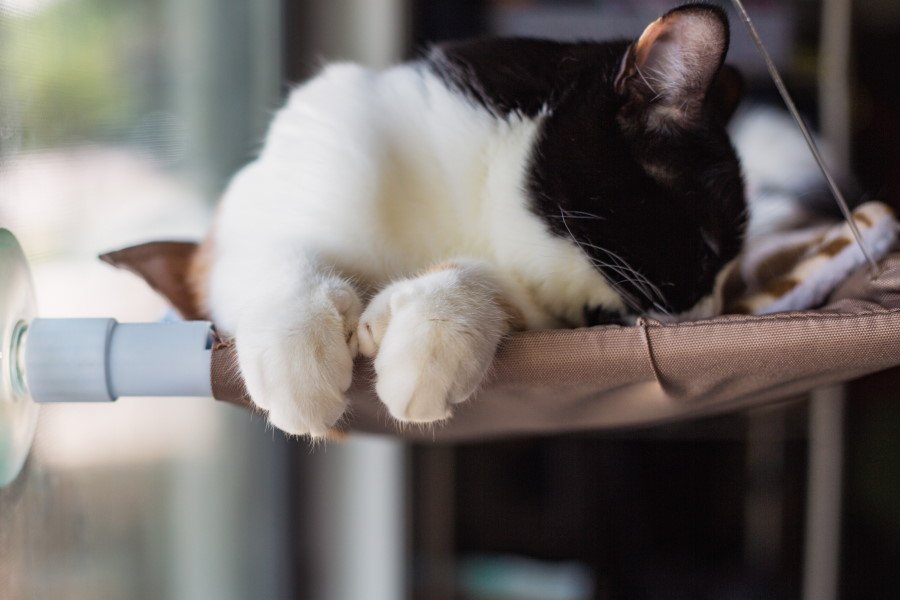
by Jonathon | | Cat Care
What is a Polydactyl Cat?
Simply put cats that are referred to as “Polydactyl cats” are cats with an extra toe on one or more of the paws. It is also referred to as hyperdactyly in some areas. It is a genetic mutation that can reoccur throughout the lifespan of a cat that has kittens with one or more kittens also having the extra toe.
Strangely enough, more polydactyl cats are seen in the United States and Canada, making it a trendy type of cat to have in North America as whole websites and individuals are devoted to this type of genetic flaw. There is no explanation anywhere why the flaw is centered in North America for the most part.
Colder Climates Favor the Mutation
More of these cats for whatever reason are centered around the West Coasts not the East Coasts of both the USA and Canada, which can lead one to believe that this occurs in colder climates not warmer ones.
But again, there is no real reason to date on why and how this occurs or real-time data or statistics. Most polydactyl cats seem to be among the Maine Coon cat breed, and this makes sense, given the fact that colder climates seem to be where most polydactyl cats mutate and appear.
It is estimated by some that 40 percent of the polydactyl mutation occurs in Maine Coon cats, and this does make sense as Maine in the USA is harsh and snowy, and an extra toe would help insulate the feet and allow a cat to walk more adeptly on snow and ice.
What is The Usual Number of Toes on a Polydactyl Cat?
While most cats have five front toes and four on the back, a polydactyl cat has six or even more on either one paw, two paws, or all four paws. Since it is a genetic mutation, it can occur in any breed but there is no way to “breed” a polydactyl to produce another polydactyl.
Aficionados of the polydactyl cat will search continuously for one if they must. The paws seem larger on a polydactyl than on other cats, since the extra toes add to the width of the foot. This makes them remarkably cute to some as most cat owners do know the paws of a cat are part of their unique cute appeal!
If a polydactyl cat develops a middle extra toe on the front paws, the paws then resemble a “mitten” as the last toe is pushed out farther.
Although the last toe then looks like a thumb it is not useful as a thumb in a human.
There is Nothing Unhealthy about a Polydactyl Cat
The cat has a normal gait and the normal habits of any other cat. The front paws are generally the most prevalent to developing an extra toe, and the only drawback is extra nail trimming which is a challenge for any cat owner all the time.
However, there is a serious health condition that is commonly confused with a polydactyl mutation. Radial hypoplasia causes extra toes too, but the toes develop over a lifetime and not immediately from kittenhood. This condition causes extra-large, and extremely flat feet, and causes gait and sometimes balance problems.
It causes severe mutations in future generations if a hypoplasia cat is bred, which is why vets do not even recommend breeding polydactyl cats as there is no way to completely control a genetic mutation.
There Can Be Advantages for a Cat with More Toes
Instead of making a cat clumsier or inhibiting the gait, a polydactyl cat can have enhanced balance, and hunt, climb and chase objects more adeptly. Of course, a scratching post is needed for these cats as they are in more need of it, or an owner’s furniture will feel the brunt of that extra toe or toes.
The more toes the more sharpening of claws occurs. That will need to be remembered if you decide to take in a polydactyl into the family. High agility can be an advantage of an extra toe for a cat, especially when at the end of the foot as it is an extra “grabber” when climbing any object and you can believe your furniture will be one of the most favorite objects.
Why Do Some Individuals Seek Polydactyl?
Many reasons. They simply look cute to many owners, while others like unique cats. Like black cats, which have a reputation for being bad luck (which is only a myth), some polydactyl fans believe that these cats bring good luck (another myth but is common among owners).
Even famous individuals like Ernest Hemingway adored polydactyl cats and he set up a museum in their honor before his death. Loving polydactyl is the same as loving any cat or preferring any breed. It is simply a personal preference with no difference in habits of affection given by this type of cat.
Conclusion:
If you would like a polydactyl cat, then search around and get one. These appear even in shelters and are quite common. However, make sure to have it vet checked to rule out the possibility of hypoplasia as most rescues or breeders are not even aware of this syndrome.
While adopting a cat with hypoplasia will not harm you or the cat physically there are challenges and of course, more vet bills as the toes can continue to grow throughout a lifetime and might need removal.
As with adopting any cat, either normal or polydactyl, you need to love it unconditionally and be prepared to work with any challenges a cat might have. Looks are not everything but unconditional love for a cat is!
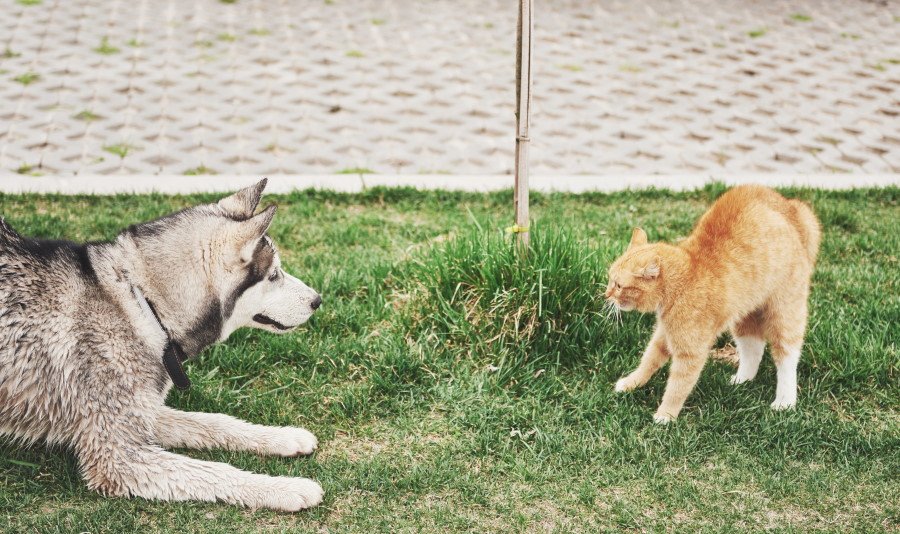
by Jonathon | | Cat Care
Cats are territorial creatures and will tolerate new animals in their space in varying degrees, so when it comes to introducing cats to dogs, be very careful.
First and foremost, do some research on both the breeds of the dog and cats and ensure they are compatible. Some highly aggressive hunting breeds or other characteristics in a dog may make them a bad match to try and socialize with a cat.
Don’t forget to consider size and weight, as this could end up being a life-threatening situation if not planned and executed correctly. A large dog, when hissed, scratched, or on the receiving end of cat aggression, may lash out in a manner that could unintentionally cause injury to the feline. Due to the size differences, it’s possible for the dog to hurt your cat without intentionally meaning to can occur.
For this and so many other reasons, there are some good guidelines for testing the water on it a cat and dog will be able to co-exist peacefully in your home.
Safety First
It is a bad idea to introduce your feline to multiple dogs at one time. This can cause them to retreat, get aggressive and immediately go on the defensive. As a good rule of thumb, ensure that you have a person available to shelter, control, and interact with each animal when introducing a cat and dog.
In addition, be sure you do not do introductions in confined spaces that can hurt the human handlers or the individual animals, should they bolt or start thrashing. Finally, give all the animals quick exit strategies if things get too tense back to their separate spaces.
Each animal should be introduced into the household in their own space. For example, both cats and dogs that have a safe place (bed, crate, etc.), their own food, and such will be that much less likely to challenge another animal for rights to shared items.
This space can also be a place of safety during initial meetings should aggression or stress occur in either animal being introduced.
Slow Introduction
After allowing both feline and dog to get acclimated to their own space, allow the first introduction through a closed door. This allows them to smell the other, hear the scratching the like without direct bodily confrontation.
As they calm and settle in with the other’s scents, then a first calm introduction with just a couple of people in the room able to restrain each animal should that be needed can occur.
Read Body Language
Be sure that your dog already understands and will respond to commands such as sit, down, come, and such. This will allow better control in doing introductions with a feline.
Dogs and cats should both be observed during the initial introductions for body language. Is the hair going up on the back of the dog’s neck, the cat hissing and backing away, and the like? These signs should cause you to keep the meeting brief and allow them to retreat to their own spaces to wind down before the meeting has a chance to escalate. You know your pets best, so stay engaged with these early interactions.
Remember, dogs can kill cats even while playing, so attentiveness to their body language and how they interact could become a life and death situation.
Age Matters
Age matters, especially for kittens and the elderly felines you may be introducing to dogs. For instance, while young kittens may not be afraid of dogs as older cats might, they are more fragile. Kittens may be more willing to engage with dogs, but a high-energy or just larger canine could end up hurting them unintentionally.
Cats that have been raised as the only fur baby in the home for years may be extraterritorial make introductions harder. Finally, older cats should be in good physical condition and be cleared of any illness or other concerns before introducing them to dogs.
This will ensure they both can’t be hurt and won’t show other outward personality concerns when introduced to dogs. Age will play a part in introducing your cat and dog fur babies and should be considered well before the first introduction happens.
In conclusion, when introducing dogs and cats, slow, steady, and prepared should be the words to keep in mind. Allow each animal their own space, with bedding, food, and toys. Introductions between healthy animals should include handlers that can manage any behaviors immediately.
Watch body language as the first introductions are made, and react calmly but appropriately. Use positive reinforcements for both, and allow separation when anxiety or other behaviors warrant it.
Hopefully, your canine and feline friends will soon co-exist in perfect harmony with patience, perseverance, and some good preparation.
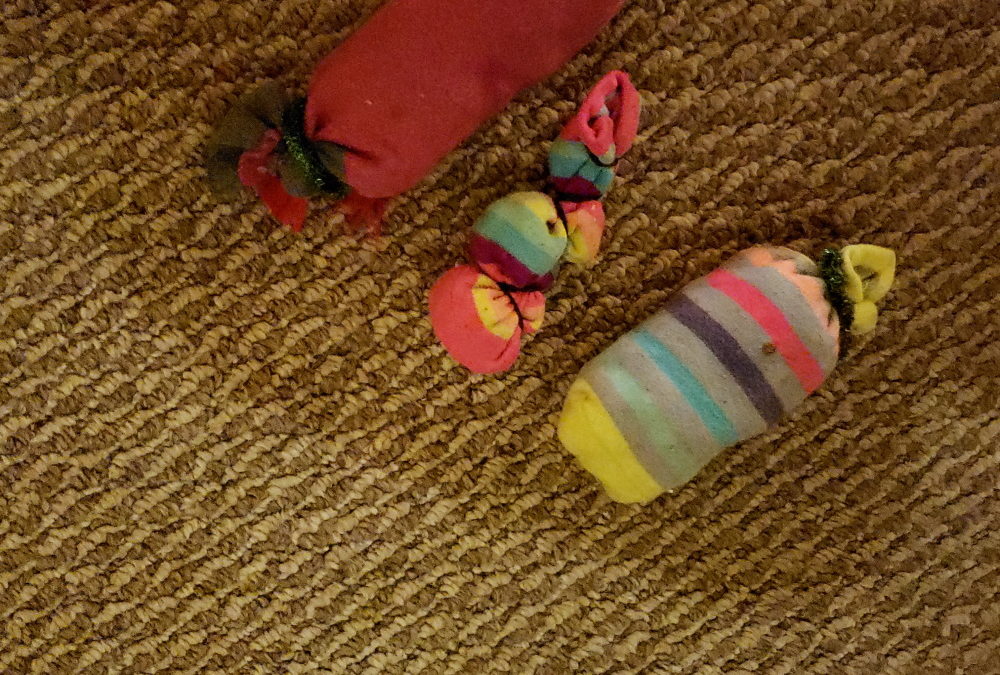
by Jonathon | | Cat Play
Cats are persnickety about toys as they are with everything. All cat owners have toys that looked appealing and sounded good, yet once purchased, were not even glanced at by your kitty or kitties. It’s just a fact of life.
Inflation also has made it somewhat difficult to provide new cat toys for our beloved feline friends. They DO get bored easily and new toys are needed constantly.
To be honest, though, especially in the USA, DIY toys for cats are making a real wave as they are safe, sustainable, and environmentally friendly, yet affordable as you can use what you have in your home already or purchase some cheap items.
Toys that look good to us do not many times impress cats. They like simple things like fishing pole-type toys and things that are fuzzy and wiggle. Do not forget the catnip as that makes any toy more appealing. Toys also help you bond with your cat.
Our 4 Top Simple, Safe, and Affordable DIY Cat Toys
-
The Play and Scratch Combo
This uses very simple items and is a scratching post combined with “whirly gigs” on top. For the scratching post which is the base, all you need is a piece of heavy wood or extra-thick cardboard. Wood or corrugated cardboard is preferred as it will not move easily. It can be any size.
To make the scratching post portion you need to cover it with carpet (cats love to scratch carpeting), or sisal fabric which is available at any home goods or pet store usually. Use non-toxic glue to attach the carpeting or sisal fabric after you cut it to size.
Use pipe cleaners that are “kid-safe” from an arts and crafts store, not regular pipe cleaners. These are not metal inside and are much thicker and more pliable. There are plain ones or glitter ones, and you can put as many as you like into the base of the scratcher. Twist them a bit to make them interesting and watch your cat bat at these endlessly whenever they are bored!
-
The Sock it to Me Cat Toys
These are amazing and cats love them. These are simply old socks (talk about recycling) of any size, or color that is threaded at the top, the bottom, or the middle (all three are best) with twine that is purchased again at a arts and crafts store and is strong and tough but non-toxic.
Fill each sock with catnip, and believe me, you will have a winner of a toy that only costs a few dollars for the catnip and art twine that your cat will find thrilling.
-
The Twirly Twizzlers Cat Toys
These are the simplest to make and the most fun, especially for kids to make. The same type of pipe cleaners that are not really used to clean pipes are purchased at the arts and crafts stores. The thickest ones and fuzziest ones work the best.
All types of shapes from stars to butterflies can be made from these as they are super flexible. Rub each one in catnip, and watch your cat carry it around and bat it around like the most expensive toy you can purchase! Hardly any cost and this is a great fun activity for kids of all ages. These pipe cleaners can even be rolled into multicolored balls.
-
The Fuzz Ball DIY Toys
This will not be for everyone. But if anyone in your family does hunt, either deer, rabbit, or squirrel, the fur and skin can be stretched and made into strips or balls. While this might seem atrocious to non-hunters, cats love real fur items and after all, you are using each part of the animal that was hunted.
The Top 4 DIY Cat Toys Are Much Needed for Indoor Cats
Indoor cats become the most bored generally especially if they were shelter cats and are used to being outside where there is a lot of stimulation. Even for outdoor cats, the rainy or cold days when your cats are trapped inside with you can be the perfect time for toys.
Summary of The Top 4 DIY Cat Toys
Cats are intelligent and need as much if not more stimulation than dogs. There are many individuals in the USA that now are focused on sustainability and protecting the environment. You can save a ton of money with our DIY cat toy suggestions and not create any toxic waste or harm to the environment.
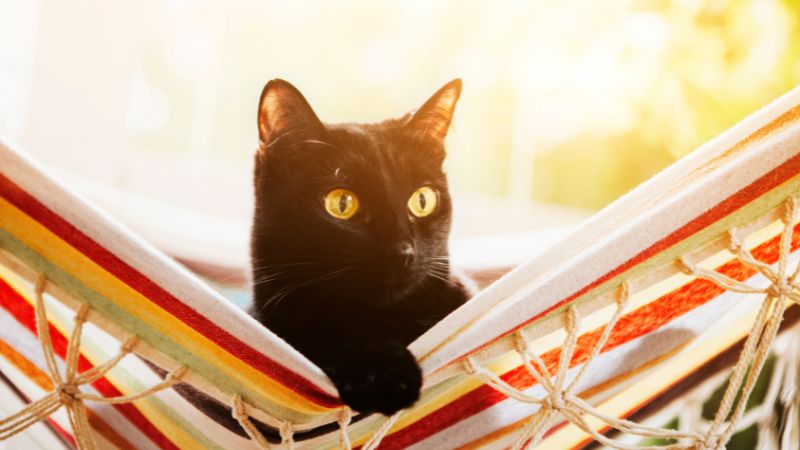
by Jonathon | | Cat Care, Cats & Sleep
While we adore making our own cat toys, scratching posts, and cat trees, nothing saves more money and is more sustainable than making your own cat hammock, or bed.
Let’s be real here. Cats in the USA are oftentimes referred to as “Box Car Willies” as they sleep in any container that is warm and cozy. This expression dates back to the early 1920s in the USA when jobless and homeless men road the cargo rail boxcars covered in cardboard and newspapers.
You can still see shelter cats sleeping in a pile of newspapers, and if you leave a cardboard box out, your own cat will oftentimes make good use of it.
Top 3 DIY Cat Beds and Hammocks That Cost Next to Nothing
-
The Cardboard Box Castle Cat DIY Bed
We are going to start with a box. A low-slung, long box, with a cozy blanket in it, and some catnip sprinkled onto it will entice any cat. Now if an accident occurs such as peeing and pooing there is no saving it.
However, it will only cost you another free box whose sides you have cut down and a cheap blanket or throw. So for practical purposes, this is a winner. If you have a wide enough window or a ledge on which to place this DIY bed it will be sturdier than a purchased soft bed and can double as a perch.
-
The Let’s Do the Laundry DIY Cat Bed
There is not much to say about this one as honestly, anyone who owns a cat knows that the laundry basket, especially when filled with warm laundry is a favorite place to snooze off.
Filling a plastic laundry basket with cheap throws or blankets will keep any cat happy. To be more sustainable, you can go for the bamboo varieties that are more popular now in the USA.
-
The DIY Cat Hammock that Hangs Anywhere
Cat Hammocks are generally loved by cats. This does not mean you need to purchase one. All you need are a throw that is heavy enough to hold the weight of your cat or cats, and a few hooks to secure it anywhere in your home.
A sunlit window is perfect. The only caution here is to make sure the throw or materials are strong enough and the hooks that you screw into the wall are also large and heavy.
If you are not a purist, simply cut holes on each end of the material and slip the hooks through it after you place them into a wall. Voila, you have a hammock!
Conclusion on the 3 Best DIY Cat Beds and Hammocks
Of all the DIY projects and cat necessities, these are the easiest as chances are you already have the components in your home. These suggestions are portable as well and you can move them easily from one spot to another.
Many decades ago, this was the way good cat owners made these necessities and they are making a huge comeback in the USA right now. Your cat will not complain and you will save money and invest in sustainable products that save planet earth!






